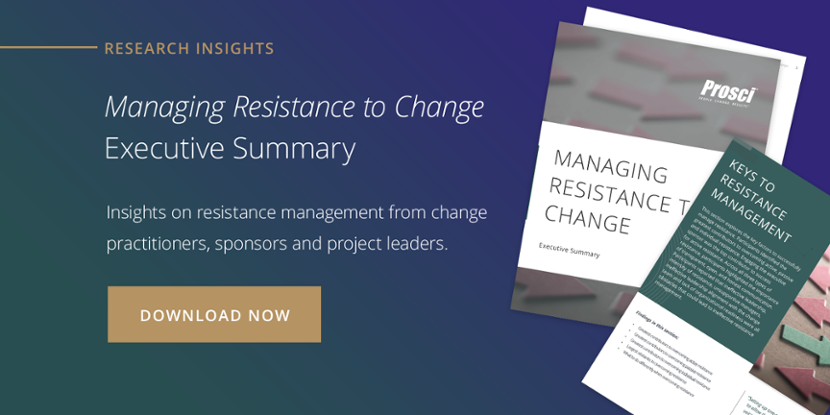3 Ways to Neutralize Resistance to Change

4 Mins
Updated: August 12, 2022
Published: July 23, 2015

In times of change, the natural reaction is to resist. Whether changes are happening at home, in the community or in the workplace, they introduce the unknown. They take us out of a place we know, a place of comfort, and force us into something new. We do not know what to expect. And we anticipate hardships and struggles as we leave the current state.
When you're introducing change in an organization, you should not be surprised by resistance. In fact, you should anticipate resistance and work to mitigate the consequences. Resistance cannot be totally eradicated, but it can be managed constructively and proactively, before the project or the people in your organization are impacted.
The Costs of Resistance To Change
Resistance to change does not come without a cost. Most organizations have countless stories about the negative and unintended consequences of resistance to change. Resistance is not merely a nuisance—the consequences are meaningful and costly.
Some costs of resistance include:
- Project delays
- Missed objectives
- Productivity declines
- Absenteeism
- Loss of valued employees
While resistance is sometimes viewed as a "soft" issue, each of the costs above can have significant financial implications for the projects and initiatives under way in your organization. Managing resistance to change is critical to achieving successful change.
Identify the root cause of resistance
One of the biggest mistakes you can make is to treat the symptom, not the cause. This is especially true when dealing with resistance to change in an organizational setting. Treating the symptom is ineffective because it does not fix what is broken. Additionally, treating only the symptom can actually further aggravate those who are resisting the change. Instead of addressing their objection, you further frustrate them.
The Prosci ADKAR Model is an effective tool for identifying the root cause of resistance. ADKAR is an acronym for the five outcomes an individual needs to achieve for a change to be successful: Awareness, Desire, Knowledge, Ability and Reinforcement. When a change is not taking hold and resistance occurs, the ADKAR Model enables change practitioners to focus on why the resistance is happening. Is the resistance cause by a lack of awareness of the need for change? Is it due to a lack of desire to change? Is it caused by lack of knowledge or a fear of not having the knowledge to be successful once the change is in place? Are there barriers to ability? Or, is a need for reinforcement causing the resistance?
Change management practitioners and people managers—the primary resistance managers in an organization—can use the ADKAR Model to understand and manage the root cause of resistance.
Make a compelling case for change
In all of Prosci's benchmarking studies, the number one reason cited by participants for employees resistance was lack of awareness of the need for change. A lack of awareness is also among the top reasons managers resisted change in both studies. In today's organizations, you must make a compelling case for a change. It's not enough to say, "Here's the change" and expect people to adopt and use it, no matter how great the change is. You have to clearly illustrate the reasons for the change AND the risks of not changing, if you hope to get employees on board.
There are a couple of interesting connections related to the compelling case for change. The case for change shows up in the ADKAR Model in the first building block - Awareness. It is basic human nature to want the answer to "why" when we are asked to change. This is true for changes happening at home as well as changes happening at work. If we are left wondering "why", we tend to hold back our support and buy-in. We begin resisting the change, not because we disagree with it, but because no one has convinced us why the change was happening in the first place. Second, in today's organizations where employees have been empowered, it is even more important to build a compelling case for change. Over the last twenty years, organizations have worked to push decision making, ownership and accountability deeper down in the organization. It is no surprise, then, that when we ask employees to "jump" their reaction is to ask "why" instead of "how high". New value systems have resulted in a more engaged workforce, but they have also affected how we must manage change.
The first step in engaging a workforce - and in addressing the greatest cause for resistance - is making a compelling case for change. When asked who employees want to hear the case for change from, participants in Prosci's benchmarking study overwhelmingly cited senior leaders as the preferred sender. You will need to work with senior leaders to ensure they are delivering effective communications about the need for change.
Engaging the "real" resistance managers
The "real" resistance managers are those who can listen to and engage resistant employees. This is not the project leader. It is not a member of the project team. It is not an HR or OD professional. And it is not the change management resource supporting a project. The "real" resistance managers are the supervisors and managers throughout your organization whose employees are impacted by the change.
Unfortunately, managers and supervisors have been identified as the most resistant group. This creates a dilemma for those introducing change. The people you need on board and involved in introducing the change and managing resistance may themselves be resistant. You must first manage the change with managers and supervisors before engaging them as agents of change with their direct reports. This means helping each of them through the ADKAR Model change process - Awareness, Desire, Knowledge, Ability and Reinforcement.
For many of your managers and supervisors, "managing resistance" is a new job role requiring skills and experience that have not been developed. It is not enough to tell managers that you need their help in managing resistance - you must provide them the training and tools they need to identify and manage resistance from their employees.
Summary
Now that we have talked about managing resistance, we need to address how we should be avoiding resistance in the first place. Most organizations experience a higher level of employee resistance than necessary because of one simple reason: they fail to manage the change with a structured process and dedicated resources for change management. This failure only results in a greater need for fire-fighting and damage control later on. Your first step for managing resistance is actually to implement effective change management at the onset of your project. If you do this, you will find that the adage "an ounce of prevention is worth a pound of cure" is really true when it comes to change and managing resistance.


